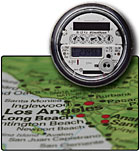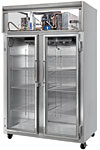
As California goes, so goes the nation. That adage may or may not have some truth to it in a lot of aspects of life, but it certainly carries weight in the refrigeration sector. The state now has in place the California Energy Commission's (CEC's) energy-consumption standards, which provides minimum efficiency standards for a wide range of refrigeration equipment - along with an equally wide range of rebate incentives for installing such equipment. Those standards are being adopted or under consideration in several dozen other states and have made their way into the national Energy Policy Act signed by President George Bush in 2005, to take effect in 2010.
But what about installing contractors? How do they figure out the minimum standards for equipment they now must install in California, they may need to install in other states, and they will need to install nationally by 2010?
One way is by taking a closer look at the Energy Star® guidelines for commercial equipment, said Robert Lehman, managing director of Emerson Climate Technologies Design Service Network, who authored a white paper issued last fall called, "The State of Energy-Consumption Legislation for Commercial Refrigeration Applications."
He said Energy Star originally started out as a voluntary program to recognize the best of the best in efficient equipment, but now has evolved into a virtual baseline for such products.
"The U.S. Environmental Protection Agency released its first voluntary energy-consumption standards for commercial refrigeration and freezers in 2001 under its Energy Star program," said Lehman. "Several states, led by California, have since released legislation mandating maximum energy consumption, with effective dates from March 2003 through January 2008.
"Typically these standards were less stringent than Energy Star requirements, but over time they achieve the Energy Star recommended limits. The states are also releasing similar legislation to limit the allowable energy consumption of commercial ice cream freezers, vending machines, ice machines, and walk-in refrigerators and freezers.
"In 2005 the Air-Conditioning and Refrigeration Institute (ARI) released a proposal to the federal government to nationalize energy-consumption standards for commercial refrigerators and freezers. The effective date of this proposal was recommended to be January 2010 with the final energy-consumption standards equal to both the original Energy Star proposals and the final California standards. In August 2005, President Bush signed the Energy Policy Act of 2005 which adopted these recommendations."
THE CALIFORNIA IMPETUS
The impact of the California initiative was strongly felt by the industry last fall during the National Association of Food Equipment Manufacturers (NAFEM) expo that took place in Anaheim. To get a handle on the situation, Danfoss invited a number of its customers, as well as national and state energy experts, to a roundtable held at that time.One of those participants, R. Michael Martin of the California Energy Commission, noted that the commission based much of its research on information published by ARI and the American Society of Heating, Refrigerating and Air-Conditioning Engineers (ASHRAE). He also said it was the intention of the commission to be sensitive to equipment costs. Martin said the standards "should not add to the total cost (of equipment) over their designed life."
On the NAFEM expo floor, refrigeration equipment exhibitors were pretty much saying, "Whatever California specifies, we will build equipment to those efficiency standards and we won't have another set of less efficient equipment for other states."
That was backed up in the intervening months as manufacturers began turning out press releases linking their newest products to the California criteria.
For example, this past May, Ice-O-Matic announced "the qualification of nearly 50 commercial ice machine models for the new California energy efficiency rebates paid by the three largest utility companies." Ice-O-Matic President Kevin Fink said, "The rebates represent approximately 10 to 20 percent of the cost of an ice machine and give California businesses a financial incentive to make the smart choice for energy efficiency."
Ice-O-Matic's parent company, Enodis, in announcing its own program called EnerLogicâ„¢ (that identifies energy-efficient foodservice equipment) also focused on the efficiency standards.
Dean Landeche, Enodis vice president for marketing, said, "EnerLogic is another step in our commitment to energy efficiency and resource stewardship."
He said products qualifying for the EnerLogic seal include those that "meet or exceed CEC rebate standards or are Energy Star rated or meet criteria outlined by the Federal Energy Management Program."

WHY THE FUSS?
California's push for stricter energy efficiencies and the willingness to include rebates to purchase such equipment is based on long-standing problems the state has had in generating enough power. Blackouts and brownouts are recurring problems, as news headlines this summer have again demonstrated."We don't have enough capacity and it will be tough getting it," said J. Carlos Haiad, project manager for Southern California Edison. That's why, he said, the state has a demand response program. In it, when there is a need, the power company calls upon customers to "drop loads" anywhere from 2 to 6 hours. That is why the utility's cash incentive program for equipment replacement is part of the rebate equation. "The program provides nonresidential customers with cash incentives for replacing existing equipment with new high efficiency equipment," he said.
In a broader sense, energy efficiency is part of energy conservation, which these days addresses both supply and security issues, said Robert Cavey, president of Global Strategy Initiative. He noted that once environmental concerns drove the push for energy conservation. Now it is a cost issue, as any contractor who drives a van or truck knows when he or she pulls into a gas station to fill up.
Cavey said adequate supplies of energy in the United States become a security issue given political instability in other parts of the world. He said, "The issue is using energy more efficiently as a value added in both business and government. Both are trying to find a way to stop spending all this money on energy."
A WORK IN PROGRESS
The whole issue of refrigeration equipment efficiencies is still a work in progress until at least 2010. Just as with 13 SEER on the air conditioning side, there are questions about less efficient equipment already in the distribution pipeline. There are questions about where each state is in regards to the issue. While California has testing procedures set up, there are questions about how other states, and eventually the federal government with its National Energy Policy, will certify equipment as meeting certain standards. There are questions about products coming from offshore.Since the California efficiency standards on the refrigeration side vary virtually piece-by-piece, as do the amount of rebates, going to a Website like that of the CEC (www.energy.ca.gov) can provide details. Contractors from throughout the United States might want to review that information since it appears the California standards are going national.
The process is not without its legal hurdles. In fact, one battle has already reached the U.S. Supreme Court. As reported in the July 3 edition of The NEWS, the high court denied a request by ARI to hear an appeal of a lower court decision that said CEC energy efficiency regulations could not be pre-empted by the Federal Energy Policy Conservation Act. Basically, the powers of the CEC to do what it was doing regarding energy efficiency regulations were upheld by the high court.
KNOW WHAT YOU ARE BUYING
Refrigeration contractors are often driven by their customers to install the most basic piece of equipment that provides adequate cooling or freezing. Often the upfront costs is much more important to the customer than the payback over the years.Actions in California that are spreading to a national policy are changing that. Now contractors need to make sure what they are buying meets higher standards and need to convince customers that not only are they doing what is required by law, but it is also a more positive payback in the long run.
Publication date: 08/21/2006


Report Abusive Comment